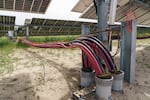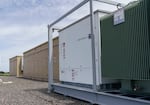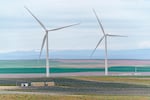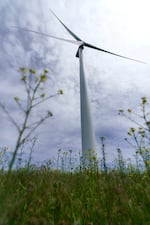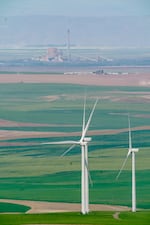A demolition contractor on Thursday imploded the towering smokestack and 19-story boiler building at Portland General Electric’s shuttered coal-fired power plant near Boardman, bringing a symbolic close to the era of coal-fired power generation in Oregon. Imported electricity generated from coal still flows through transmission wires across the Pacific Northwest, but that looks to be winding down soon, too.
Watch a video of the demolition:
Strategically placed explosives toppled the 656-foot tall stack like a logger might fell a tree and collapsed the adjacent boiler building into a heap of concrete chunks and twisted steel. In seconds, a huge cloud of dust enveloped the partially disassembled coal plant. A small crowd of onlookers invited by PGE, including former plant workers oohed and aahed, but mostly refrained from clapping or cheering as the moment was tinged with sadness or melancholy for many.
“Very emotional for me and very emotional for a lot of the people that I worked with for a number of years,” said PGE Vice President of Utility Operations Brad Jenkins, a former plant manager at Boardman.
“The coal plant has been just a workhorse of the fleet for 40 years,” Jenkins said. “But if you look around the landscape here, we’ve got lots of clean, renewable resources coming in. We’re transitioning and this is just part of that transition.”

The towering smokestack at Portland General Electric’s shuttered coal-fired power plant near Boardman has fallen, heralding the end of the era of coal-fired power generation in Oregon, Sept. 15, 2022.
MacGregor Campbell / OPB
PGE livestreamed the controlled demolition on social media but did not enable comments. Before the explosion, a smattering of people on the utility’s Facebook page bemoaned the demise of the coal plant. A recurrent theme among those commentators was that the Northwest needs reliable, baseload power such as what Boardman provided to balance intermittent renewable energy sources.
Jenkins said the fleet of natural gas power plants in the region would provide grid stability for the coming years until those are phased out and replaced with developing, zero emissions technologies.
A long legacy in Mid-Columbia up in a cloud of smoke and dust
The Boardman coal plant operated from 1980 until its early retirement in 2020. It is located in Morrow County about 11 miles southwest of Boardman – where the closest residences are -- and about an hour’s drive upriver from the east end of the Columbia River Gorge. The plant’s 585-megawatt generating capacity was for a long time the single biggest electricity source for Oregon’s largest utility. It was also the state’s single largest source of climate-warming pollution. There are now no coal-fired power plants operating within the state of Oregon.
“It’s sort of bittersweet,” said Morrow County Commissioner Don Russell, who befriended many of the coal plant workers and had a view from his house of the landmark stack, which was taller than Seattle’s Space Needle. “The roughly 125 permanent jobs that they had out there were really coveted jobs.”
“For Morrow County, at one time this plant was our largest taxpayer by a really large margin,” Russell added before watching the demolition from the viewing area. He said the plant closure had limited economic effects though because the rural county has lately diversified its economy with Amazon data centers and a number of renewable energy projects.
PGE executives decided more than a decade ago to shut the Boardman plant down by 2020 when the economic and environmental outlook for coal power darkened. The announcement helped settle a Clean Air Act lawsuit brought by green groups, plus PGE avoided having to make costly emissions control upgrades down the road.
The closure eliminated about 2 million tons of greenhouse gas emissions that were coming from the plant every year. (That amount of carbon dioxide equals the annual pollution from about 431,000 passenger cars in average use, according to the EPA’s greenhouse gas calculator.) The closure also ended mercury and sulfur dioxide emissions that were blamed for haze and air pollution in the surrounding area and the Gorge scenic area.
In the short term, PGE replaced the electricity from Boardman with a wide mix of other resources, partly purchased on contract from other generators. Jenkins said renewables will play a prominent role going forward, potentially including a company-owned 50 MW solar farm proposed for the coal plant site that could repurpose the existing transmission connections. He also praised the reliability and flexibility of PGE’s large natural gas-fired power plant at Boardman, the Carty Generating Station, which opened in 2016 across the street from the former coal plant.
The transition from old to new is also reflected in the immediate area at PGE’s Wheatridge wind, solar and storage battery complex, which went fully online in central Morrow County earlier this year.
PGE spokespeople said some of the Boardman coal plant workers retired when the plant was decommissioned, many transferred to other roles in the company and some are working on the demolition, leaving very few who were laid off.
Going on five years ago, some community members in Eastern Oregon had hoped to keep the large power plant running with an alternative fuel source. One option that was tested was running the boiler on wood chips or charcoal-like pellets made from woody debris thinned out of Northwest forests to reduce wildfire risk. This had the potential to provide a dual benefit: to make forest restoration more economically viable by turning the thinnings into a valuable commodity and to extend the life of the power plant and its rural jobs with a sustainable fuel source.
PGE briefly experimented with woody biomass and discovered it was feasible, but eventually rejected the fuel conversion option amid doubts about whether the fuel would be cost competitive with other renewable resources.
Only one coal plant remains in the Northwest
The demolition of the Boardman coal plant leaves one coal-fired power station operating in the Northwest, the TransAlta coal plant in Centralia, Washington. But its days are numbered too, for the same reasons the Boardman plant shut down. Under pressure to cut emissions, TransAlta struck a deal with Washington’s governor and the state legislature to retire one of the plant’s two units in 2020 and fully stop burning coal by the end of 2025.
Even with the Boardman coal plant gone and TransAlta on the way out, there is a notable amount of electricity generated from coal still coursing across transmission wires into Northwest homes and businesses. The most recent figures for the statewide power generation resource mix posted by the Oregon Department of Energy showed coal accounted for 26% of the electricity on the state grid in 2020, behind hydro at 40% and ahead of natural gas (21.5%) and wind (7%).
Washington state relies more on hydroelectric generation than its neighbors (hydro’s share is approx. 55%), but its electric utilities’ overall resource mix still included about 10% from coal as of 2020, according to an analysis by the Washington Department of Commerce. Coal was in third place, right behind natural gas (13%) and ahead of wind (5%) and nuclear (4%).
Besides the juice from the Centralia coal plant, the coal power on the grid in the Northwest today mainly comes from large power plants near coal mines in Wyoming, Montana and Utah. The electricity buyers are chiefly the investor-owned utilities in the region – PGE, Avista, Idaho Power, Pacific Power and Puget Sound Energy. Public utilities get first dibs on the wholesale hydropower and nuclear energy distributed by the Bonneville Power Administration.
Between 2016 and 2021, the Oregon Legislature passed some of the most aggressive clean energy laws in the nation. Lawmakers first set a deadline of 2030 to kick coal-powered electricity off the grid completely in the state. A follow up measure last year requires the state’s biggest utilities, notably PGE and Pacific Power, to reach zero emissions for all electricity generation by 2040.
In Washington state, utilities must ditch all electricity generated from coal by the end of 2025 under clean energy rules passed by the Legislature in 2019.
Some environmental interests, including the Sierra Club’s Beyond Coal campaign, are pressuring Northwest utilities and state regulators to accelerate the phase out of coal in order to reach self-imposed climate goals and protect public health.
A PGE spokesperson said the utility expects the demolition and decommissioning of the Boardman coal plant to be fully complete by the spring of 2023. Thursday’s explosive takedown of the tall smokestack was orchestrated by contractor Brandenburg, a big name in the specialized world of blowing up industrial relics.
Watch the crowd react to the demolition of the smokestack.




